Institutional trading refers to the buying and selling of large quantities of securities by organizations such as banks, hedge funds, pension funds, and other financial institutions. These trades often involve substantial amounts of money and require sophisticated strategies to achieve optimal results. One tool that has become increasingly important in the world of institutional trading is the trading bot. Trading bots are automated software programs that execute trades on behalf of traders based on predefined criteria. In this article, we will explore the role of trading bots in institutional trading, their benefits, challenges, and future outlook. Traders looking to navigate the complexities of institutional trading can find valuable insights and expert advice at the-immediate-catalyst.com. Learn more now!
The Evolution of Trading Bots in Institutional Trading
Trading bots have a long history in institutional trading, dating back to the early days of algorithmic trading in the 1970s and 1980s. However, it was not until the late 1990s and early 2000s that trading bots began to gain widespread adoption among institutional traders. This was largely due to advancements in technology, such as faster computers and improved connectivity, which made it possible to execute trades more quickly and efficiently than ever before.
Today, trading bots are an integral part of the institutional trading landscape, with the majority of trades on major exchanges being executed by these automated programs. These bots are capable of analyzing large volumes of data in real time, identifying trading opportunities, and executing trades at lightning speed.
Benefits of Trading Bots for Institutional Traders
One of the key benefits of trading bots for institutional traders is their ability to execute trades quickly and efficiently. This is particularly important in today’s fast-paced markets, where even a slight delay in execution can result in missed opportunities or losses. By using trading bots, institutional traders can ensure that their trades are executed at the best possible prices, maximizing their profitability.
Another benefit of trading bots is their ability to analyze large volumes of data in real time. This allows institutional traders to identify trading opportunities that would be impossible to detect manually. For example, trading bots can analyze news headlines, social media posts, and other sources of market information to identify trends and patterns that may impact the price of a security.
Types of Trading Bots Used by Institutional Traders
There are several types of trading bots used by institutional traders, each with its own set of advantages and disadvantages. One common type of trading bot is the arbitrage bot, which exploits price differences across different markets to generate profits. These bots are particularly popular in the cryptocurrency markets, where prices can vary significantly between exchanges.
Another type of trading bot is the trend-following bot, which identifies and capitalizes on market trends. These bots are designed to buy securities that are trending upwards and sell securities that are trending downwards, to profit from the price movements.
Market-making bots are another type of trading bot used by institutional traders. These bots are designed to provide liquidity to the market by placing buy and sell orders at various price levels. By doing so, market-making bots help to ensure that there is always a ready supply of securities available for trading, which can help to stabilize prices and reduce volatility.
Challenges and Risks Associated with Trading Bots in Institutional Trading
While trading bots offer many benefits to institutional traders, they also come with several challenges and risks. One of the main challenges is the technical complexity of these bots, which can make them difficult to set up and maintain. Institutional traders need to have a good understanding of programming languages such as Python or C++ to develop and maintain their trading bots.
Another challenge is the regulatory environment in which trading bots operate. In many jurisdictions, there are strict regulations governing the use of automated trading systems, which can make it difficult for institutional traders to use these bots legally. Additionally, there is a risk of market manipulation associated with trading bots, as some traders may use these bots to artificially inflate or deflate the price of a security for their gain.
Case Studies: Successful Implementation of Trading Bots by Institutional Traders
Despite these challenges, many institutional traders have successfully implemented trading bots into their trading strategies. One example of this is Renaissance Technologies, a hedge fund that has been using trading bots to generate consistently high returns for its investors for over three decades. Renaissance’s trading bots are based on complex mathematical models that analyze market data to identify trading opportunities.
Another example is Goldman Sachs, which has been using trading bots to execute trades on behalf of its clients for many years. Goldman’s trading bots are designed to execute trades quickly and efficiently, ensuring that its clients’ orders are filled at the best possible prices.
Future Outlook: The Role of AI and Machine Learning in Enhancing Trading Bots
Looking ahead, the role of trading bots in institutional trading is likely to continue to grow. One area where we can expect to see significant advancements is in the use of artificial intelligence (AI) and machine learning to enhance trading bots. These technologies have the potential to make trading bots even more sophisticated and effective, allowing them to analyze large volumes of data and identify more complex trading opportunities.
Conclusion
In conclusion, trading bots play a crucial role in institutional trading, enabling traders to execute trades quickly and efficiently, analyze large volumes of data in real time, and identify trading opportunities that would be impossible to detect manually. While trading bots come with their own set of challenges and risks, many institutional traders have successfully integrated these bots into their trading strategies, leading to improved performance and profitability. As technology continues to advance, we can expect trading bots to become even more sophisticated, further enhancing their role in institutional trading.
Image Source: BigStockPhoto.com (Licensed)
Disclaimer
Cryptocurrency products are unregulated and can be highly risky. There may be no regulatory recourse for any loss from such transactions.
The Information on this website is provided for educational, informational, and entertainment purposes only, without any express or implied warranty of any kind, including warranties of accuracy, completeness, or fitness for any particular purpose.
The Information contained in or provided from or through this website and related social media posts is not intended to be and does not constitute financial advice, investment advice, trading advice, or any other advice.
The Information on this website and provided from or through this website is general in nature and is not specific to you the user or anyone else. You should not make any decision, financial, investment, trading or otherwise, based on any of the information presented on this website without undertaking independent due diligence and consultation with a professional broker or financial advisory.
You understand that you are using any and all Information available on or through this website at your own risk.
The trading of Bitcoins, alternative cryptocurrencies has potential rewards, and it also has potential risks involved. Trading may not be suitable for all people. Anyone wishing to invest should seek his or her own independent financial or professional advice.
Related Categories: Invest, Reviews, Tech







